The following is Lee Traynor’s synopsis of The Skeptics Society 2005 Conference at Caltech. Lee Traynor is Skeptic’s agent in Europe. He also teaches English for Science at the University of Hannover, Germany (www.fsz.uni-hannover.de) and in his spare time is preparing a Ph.D. thesis on how evolution is presented in German school textbooks. [email protected]
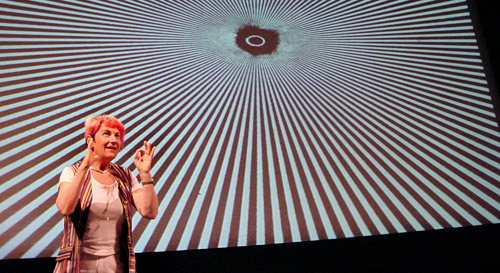
Susan Blackmore demonstrating an illusion
Brain, Mind & Consciousness
The Skeptics Society 2005 Conference
a synopsis of events by Lee Traynor,
with photos by David Patton, Emrys Damon Miller,
and Noirin & Paul of the Irish Skeptics Society
Hundreds of people from all over the United States, Canada, and Europe had gathered at Caltech and the Westin Hotel in Pasadena, California to resume the tradition of the Skeptics Society annual Caltech science conference over the weekend of May 13–15, 2005. The evening prior to the conference itself consisted of informal conversations, reunions, and entertainment. The first act was breaking ground for the skeptics: satirist singer-songwriter Roy Zimmerman proved his political incorrectness with such numbers as Defenders of Marriage, Psychedelic Relic, and Shun Evolution, followed by an encore: Call Me a Chicken-Hawk. Commenting on George W. Bush’s statement that John Kerry’s Vietnam wartime heroism was “greater than mine,” Zimmerman quipped, “Sometimes satire just writes itself.”
Zimmerman was followed by Bob Friedhoffer (aka the ‘Madman of Magic’), who lived up to his nom-de-plume. Bob’s speciality is hands-on magic with quite a number of props that are or can be made of household objects. If you want to make water disappear, you can find the props in a supermarket. Ditto if you want water to defy gravity. But magic can be at the same time entertaining and educational. Water can defy gravity if you marshal air pressure to do it. Completing his brief tour of science and magic, Friedhoffer’s ‘Little Paper Balls over the Head’ was truly masterful. We could see how the trick was done, while the subject could not.
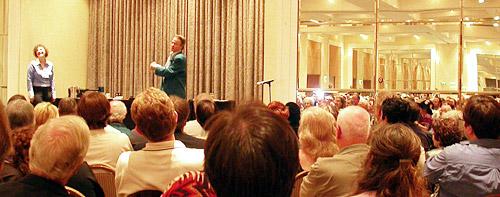
Mentalist Mark Edward demonstrating mind reading
Mentalist Mark Edward followed Friedhoffer as Friday night’s entertainment finale. Edward is a mentalist, a magician (although he said he doesn’t perform ‘tricks’) who does mind reading. Mentalism relies to a certain degree on how our powers of observation may be limited, even when we observe something ourselves, and also that we tend to trust other people and are unwilling to admit when we might be manipulated. One of the tricks of mentalism is to have all your bases covered—regardless of the subject’s reply, pretend that the response is the correct one and take credit for all hits.
Friday evening and all day Saturday included an exhibition by Jerry Andrus, possibly the world’s greatest producer of optical illusions. What do illusions have in common with the theme of the conference? This much: Any theory of the senses, and thus of consciousness, has to be able to explain illusions. Take reverse-depth illusions, for example. Andrus displayed a cardboard ‘bolt’ with a ‘thread’ protruding out of the ‘bolt.’ How are we able to see the ‘bolt’ with the ‘thread’ on the inside? All theories of sight, up to and including Descartes, fail to explain illusions such as this because they assume that what we see is 1:1 with the world around us. We see ‘bolt’ and ‘thread’ in the right relationship because it ‘makes sense.’ Andrus impressed everyone who visited his display of illusions.
Opening the scientific session of the conference in Beckman Auditorium at Caltech early on Saturday morning, Skeptics Society Executive Director Michael Shermer began by discussing the common paranormal fallacy that free will and consciousness are somehow explained by quantum mechanics. Shermer explained that quantum effects are two to three orders of magnitude below that necessary to be effective at the level at which neurons operate in the brain where consciousness is likely to be found. Shermer then showed a video clip from his television series, Exploring the Unknown, in which he was filmed in Michael Persinger’s lab at Laurentian University in Sudbury, Canada, where subjects undergo stimulation of their temporal lobes in an attempt to trigger out of body experiences. Shermer then recounted his own alien abduction experience he had as a result of extreme sleep deprivation, and concluded that all such apparently supernatural occurrences are the result of perfectly natural causes inside the brain.
As an introduction to the conference proper Roger Bingham, of the Center for Brain and Cognition at the University of California, San Diego, discussed the functionally plastic neural substrate that gives rise to consciousness. Bingham also admitted that since he had last spoken at a Skeptics conference in March of 1996, in which he defended evolutionary psychology, his views on nature vs. nurture had swayed more towards the latter, although the mind would have to evolve as the body does. Bingham quoted a review of his book, Origin of Minds, in which the reviewer, Michael Shermer, called Bingham an evolutionary psychology revisionist. Bingham explained that, in fact, even that was too conservative. He is now very skeptical of the evolutionary approach to psychology.

Shoshana (volunteer) and Sarah (staff) at the registration table
The first speaker of the morning session was Christof Koch, Professor of Cognitive and Behavioural Biology at Caltech and a long-time collaborator of Francis Crick in their attempt to find the neural correlates of consciousness. Koch commented that consciousness—which represents but a small amount of the brain’s activity—is a slow process. For most routine behavior, consciousness actually gets in the way of smooth functioning. Why do we need it then? Koch suggested it was there for unexpected events. Some visual illusions apparently do not require consciousness of a stimulus—such as a negative after-effect illusion that does not require consciousness of the square of color that causes it. Finally, it appears that consciousness, or something like it, can reside in single cells—there is a measurable ‘grandmother cell’ effect. Koch presented the results of his own research in this area, in which subjects undergoing brain surgery to relieve epileptic seizures had electrodes implanted in specific neurons in the visual cortex. Those neurons responded to specific illustrations presented to their visual field, including, amusingly, a picture of President Bill Clinton. “This is the Clinton neuron” Koch joked. The point is that whatever consciousness is, it must be located in the activity of neurons.
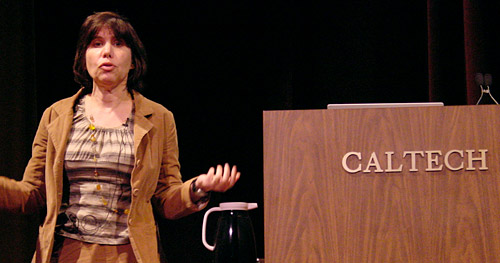
Alison Gopnik speaking on child development
Alison Gopnik, a professor of psychology at the University of California at Berkeley observed that, across species, long immaturity correlates with higher intelligence and greater flexibility. Human babies are R&D machines, continually doing experiments with their environments and evaluating the outcomes—the child as a scientist (and perhaps vice versa). However, as the child develops trade-offs may have to be entered into: between learning something new or repeating an old behavior; between plastic and efficient actions, and between awareness and automaticity. I think also that as people grow older their lives take them in certain directions to the expense of learning new things (a premium is placed on performing a smaller subset of actions expertly). Certainly it is not easy keeping all the options obtained in childhood open. Gopnik ruminated on the implications of this research on several philosophical issues that are influenced by psychological research, and in the first panel discussion she and Koch got into a passionate debate over nature and nurture, with Koch emphasizing the former and Gopnik the latter.

attendees eating lunch at the fountains
A catered lunch break followed the morning session and panel discussion, in which the 750 attendees enjoyed a spectacularly beautiful sunny Southern California day, dining on Mediterranean cuisine under the shade of the many trees and fountains dotting the pleasant Caltech campus. A book table staffed by volunteers from the Skeptics Society included titles by most of the speakers, along with back issues of Skeptic magazine and videotapes and DVDs of twelve years of lectures and conferences hosted by the society at Caltech.
After the lunch break, Harvard psychologist Richard McNally reported on his investigations of false memories in two fields: childhood sexual abuse and alien abductions. He was well aware of the difficulties of using recovered memories of childhood sexual abuse as corroboration of the abuse, so he decided to investigate alien abductees, whose memories were almost certainly false, using a group of people who denied having been abducted by aliens as a control. Abductees were aware of attempts to explain their experiences as a product of sleep-paralysis, but they insisted nonetheless on the veracity of their memories as representing actual alien abduction events. However, when compared to controls they showed higher magical ideation and absorption (the ability to identify with characters in a story, for example) and were thus more fantasy-prone. The implications of this research, McNally concluded, were that the emotional intensity of a memory is no indication of its veracity. False memories of events are just as traumatic as real memories of events.

Terry Sejnowski, Director of Salk Institute’s computational neurobiology lab
Terry Sejnowski, the Director of the computational neurobiology lab at the Salk Institute in San Diego debunked the notion that a stimulus follows a single pathway culminating in an action (‘monkey see, monkey do’); instead, Sejnowski shows how his research focuses on the intrinsic brain activity that is present without stimulus and which may represent, at least in part, a neural correlate of consciousness. Instead of a single pathway, a stimulus comes into the brain and gets bounced around through multiple systems before it ends up at its final destination. There is no one-to-one correspondence between stimulus and response. Sejnowski’s research has also led him to study differentiated patterns of neural activity during sleep, which reverse depending on whether the sleep is lighter or deeper. Such a pattern of activity, Sejnowski concluded, suggests that sleep supports learning, especially as it involves the areas of the brain usually associated with learning—the hippocampus and the neocortex. Although sleep and dreams may have ancillary functions, Sejnowski believes that the primary function is the retention of learned memories.
Susan Blackmore, a one-time paranormalist turned skeptic after her research demonstrated no evidence for the paranormal, presented a brilliant outline of the major problems in consciousness research, noting that all dualistic theories of consciousness end in contradiction; there is no Cartesian Theatre in which a homunculus watches what happens and controls subsequent outcomes. The most animated speaker of the day, Blackmore orchestrated an audience participation activity that replicated Libet’s experiments demonstrating that motor action potentials appear before a decision to move is made. That is, free will is an illusion. Something in your brain makes a decision to, say, move you hand. A moment later, you consciously decide to move your hand. But the decision to move it and the impulse was already well under way. My own take here is that there could be a ‘will you, won’t you’ cell that transmits its decision simultaneously to both ‘consciousness’ (which then realizes, “This is my decision”) and the motor neurons concerned (which quickly execute the decision). Consciousness appears to be a little behind the process (dynamic illusions of reverse depth can be particularly revealing here). Blackmore made the strongest case for consciousness being an illusion of sorts, and she did so in a very entertaining and informative manner.
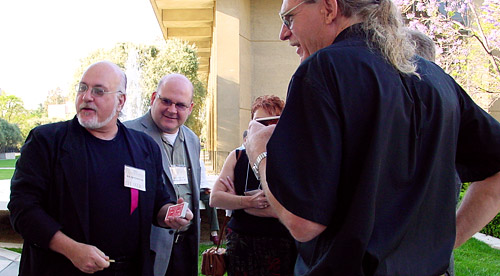
during a break, Bob Friedhoffer ‘Madman of Magic’ (left)
entertains Arizona skeptic Chuck Lemme (an early supporter of this conference)
Caltech neuroscientist John Allman presented work on specialized neurons, Von Economo cells, and their relationship to human social behavior. Von Economo cells arose 10–12 million years ago and are thus shared by humans, chimpanzees and gorillas, but are not found in any other mammals. It appears that these cells play a key role in past parallel processing and decision-making that Allman calls intuition. Intuition determines the outcome of limited-time social interactions (how do we know when to trust someone else and have next-to-nothing to go on?). It appears that in people with Asperger’s syndrome, a form of autism, the Von Economo cells are positioned incorrectly in the brain and patients are unable to take part in normal social bonding.
Neuroeconomics and trust were the subjects next on the agenda with Paul Zak, professor of economics at Claremont Graduate University. What causes prosperity? In general, it is a measure of trust. And what is trust? Zak has investigated how people trust using a social dilemma game. In a two-subject format, Subject 1 (S1) receives $10; he has the option to give some or all of it to Subject 2 (S2). Whatever S1 gives to S2 is tripled in value. S2 then has the option to give some or all of the money back to S1. Once again, whatever S2 gives to S1 is tripled in value. On average the initial donor comes out of the experiment with $14, the initial recipient with $17. Apart from the ‘bastards’ (Zak’s technical term for those who do not return anything), most people are generous within limits when receiving a trust signal, which is thought to be mediated by the hormone oxytocin, which has long been known to lead to social bonding between infants and their nursing mothers because it is released during breast feeding. New research shows that oxytocin is also released during sex, especially after orgasm, so it may have evolutionary links to pair bonding in highly social mammals. Zak then linked trust to both biochemical changes in the body (more trust leads to higher levels of oxytocin) as well as social, political, and economic conditions.
Does the mind exist at all? Hank Schlinger, a psychologist at California State University, Northridge, was skeptical of the concept of mind and consciousness altogether. Mind as an Aristotelian or Cartesian concept, he said, is outdated. But what is it we are talking about when we are doing ‘mental’ activities? Is mind “nothing but a word”? Schlinger proposes that mental activities such as reading or performing calculations are nothing but suppressed, internalised behaviours, and he traces their development to the parallels that occur in learning them: we start out reading aloud, then we are encouraged to read more quietly, then we are reinforced to just move our lips, etc. In part this radical behavioural approach was directed against the still current wave of cognitivism in psychology, of which Schlinger is also skeptical. Schlinger’s article on the mind as nothing but a word will appear in the next issue of Skeptic magazine. A hard-core Skinnerian behaviorist, Schlinger emphasized in his talk that we too easily slip into the reification of words. That is, we use words like “mind” metaphorically, but in so doing it becomes easy to think of the mind as something that actually exists, which it does not, says Schlinger.
The last scientific speaker of the conference was Ursula Goodenough, a professor of biology at Washington University, St. Louis, who is concerned with the evolution of emergent systems, i.e. novel qualities that appear as systems become more complex, for example, human culture. Humans construct cultures and are then selected for their ability to survive in them. Part of this involves the development of a moral sense, two examples of which are moral attitudes towards xenophobia (in Goodenough’s words “just bullshit”) and ecological indifference. The survival value of our moral understanding of such issues depends heavily on developing symbolic language in which they can be expressed. Goodenough emphasized that as symbolic language users humans have a special ability, and therefore moral duty, to rise above our baser natures and develop the moral potentials that are built into our natures and that we inherited as a complex social primate species.
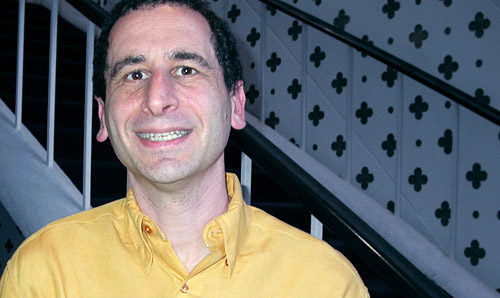
Mike Reiss, producer and writer for The Simpsons, heads in to hear the other speakers
After a catered dinner break in which the attendees enjoyed an Italian spread, the evening’s entertainment was kicked off again by Roy Zimmerman (“back by popular demand” Shermer explained) with a couple of selections from his CDs Homeland and Security. His performance earned two standing ovations. Mike Reiss, co-producer of the television series The Simpsons, provided an hour of hilarious insights into Simpsonian humour (“What’s it like to get a Harvard education? Take $150,000 into your backyard and burn it.”) interspersed with various clips from the series. Reiss was unbelievably funny. Not a single joke bombed. I would have thought that act was hard to follow—except that that last act was the Amazing One himself. In fact, as a leadover, one of the last questions asked of Reiss was: when was Randi going to appear on The Simpsons (other skeptics/scientists have, such as Gould and Hawking, and Lisa Simpson reads Junior Skeptic). Reiss dodged the question by smiling, saying “thank you,” and exiting the stage.
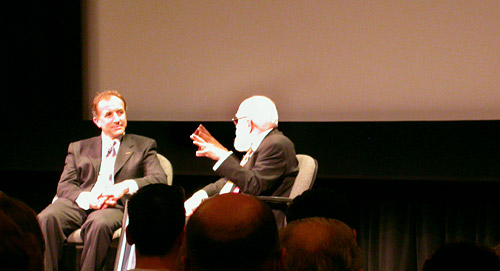
Michael Shermer and James Randi in conversation
In conversation with Michael Shermer, The Amazing Randi reviewed a number of his achievements on video as well as commenting on them live. Among other things shown was Randi suspended above the Niagara Falls as he worked his way out of a straight jacket. In September, 2004, I was Randi’s interpreter when he was awarded the Erwin Fischer prize of the international Federation of Atheists in Cologne, Germany. As Randi and I watched that sequence, he whispered into my ear, “Lee, you know I never got that jacket back.” As usual Randi’s remarks helped illuminate “behind the scenes” the way the media work (and sometimes don’t). Randi received standing ovations at both the beginning and the end of his interview for what he is: our hero.
Formal conference proceedings were thus ended—with over 750 attendees, a near sell-out crowd for Caltech’s largest venue. Don’t wait for long for tickets to the next one, which is slated for May 12–14, 2006.
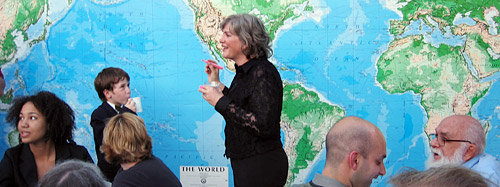
Julia Sweeney hosting activities at her garden party
Sunday lunchtime was devoted to a brunch at the Westin and was an extended opportunity to chat with other people attending. I am told that quite a number of people went to Julia Sweeney’s Letting Go of God show in Hollywood in the afternoon, which was followed by a catered dinner and party at Julia’s home, all generously donated by Julia as part of the fundraising campaign of the Skeptics Society.
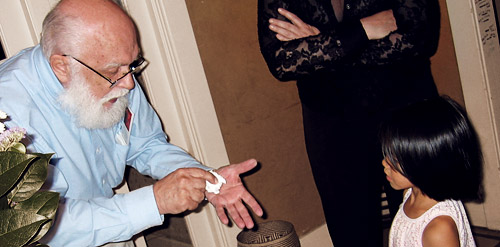
James Randi entertains Julia’s daughter Mulan
Trying to summarize the conference in just a sentence or two is like trying to confine space itself. But how do these topics touch skepticism as it is commonly perceived? The most important point is that consciousness is not all it is made out to be. Countless illusions presented by the speakers attested to this. “Believe me, I saw it”? Unlikely. Secondly, there’s the matter of trust and quick decision making. Quick—yes. Reliable—maybe, maybe not. As one skeptic once said: “Exiting an aircraft at 30,000 feet without a parachute is jumping to a conclusion.” Scientists have to perform careful, in-depth investigations and even then, they might still be wrong. Finally, the question of evolution: minds evolved. Our human brand of consciousness will turn out to be different from that of other animals in many respects, but it will also share some characteristics. It is that shared heritage that intrigues scientists.
JPL was holding its annual open house that same weekend, so I headed in that direction. Honestly. Somehow, however, I ended up at an exorcism instead, but that’s a story for another edition of eSkeptic.
Continue the dialogue! All are invited to discuss any of the topics from the conference via the Skeptic Forum.









